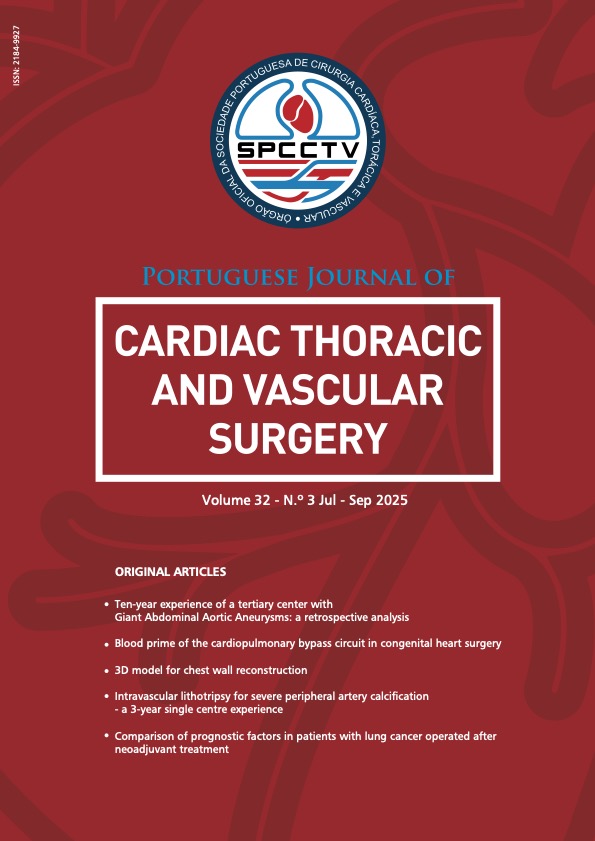Blood Prime Of The Cardiopulmonary Bypass Circuit In Congenital Heart Surgery
DOI:
https://doi.org/10.48729/pjctvs.557Keywords:
Congenital Heart Defects, transfusion, Cardiopulmonary Bypass, UltrafiltrationAbstract
Introduction: The use of cardiopulmonary bypass (CPB) is necessary during the repair of most congenital heart disease (CHD). The surface area of the CPB circuit and the volume of the filling prime are relatively large concerning the volume of neonatal and pediatric patients. Consequently, blood is often required to maintain an adequate hematocrit (HCT) level throughout the procedure.Objective: To evaluate the effects of ultrafiltration (UF) of the blood prime from the cardiopulmonary bypass circuit in children undergoing surgical procedures to correct heart disease.
Methods: This is a prospective interventional study with convenience sampling of fifty-five children undergoing elective one of two groups as follows: control group (group 1) not using ultrafiltration of blood prime and experimental group (group 2) with UF of the prime before CPB. Blood samples were obtained for analysis of CPB circuit prime, during the intraoperative and after surgery in immediate postoperative period (IPO). The duration of mechanical ventilation (MV), intensive care unit (ICU) stay, and length of postoperative hospital stay were compared between the 2 groups.
Results: Levels of glucose, potassium and lactate values demonstrated a significant decrease after prime ultrafiltration in group 2, however an increase in sodium values was revealed (p= <0,001). In the present study, to postoperative clinical outcomes, there was not difference between groups in the duration of mechanical ventilation and ICU stay. However , length of postoperative hospital stay, group 1 demonstrated longer time in comparison with the group 2 [13 (6 – 35) vs 9 (6 – 34); Median (interquartile range) and p= 0.032]. Group 2 demonstrated lower lactate values in intraoperative and in the immediate postoperative period (p= 0.008). It was observed in the first postoperative 24 hours, stability in lactate levels between the groups.
Conclusion: Analysis of intraoperative and postoperative laboratory outcomes showed overall stability in blood parameters, with some specific variations in potassium and lactate levels. The observation of a shorter hospital stay in the group that had the prime ultrafiltration, it is suggested that this technique may help shorten the hospitalization period.
Downloads
References
Aragão JA, Mendonça MP, Silva MS, et al. The epidemiological profile of patients with congenital heart disease undergoing surgery in the heart hospital. Rev Bras Ciênc Saúde. 2013;17(3):263-8. https://doi.org/10.4034/RBCS.2013.1703.08
Rosa RCM, Rosa REM, Zen PRG, et al. Cardiopatias congénitas e malformações extracardíacas. Rev Paul Pediatr. 2013;31:243-251. https://doi.org/10.1590/S0103-058220130000000017
Belo WA, Oselame GB, Neves EB. Perfil clinico-hospitalar de crianças com cardiopatia congénita. Cad Saude Colet. 2016;24(2):216-20. http://doi.org/10.1590/1414-462X201600020258
Souza PC, Gigoski VS, Eiges CL, et al. Findings of postoperative clinical assessment of swallowing in infants with congenital heart defect. Codas. 2018;30(1):18. http://doi.org/10.1590/2317-1782/20182017024
Born D. Cardiopatia congénita. Arq Bras Cardiol. 2009;93(6):130-132. https://doi.org/10.1590/S0066782X2009001300008
Malta DC, Duarte EC, Escalante J/C, et al. Mortes evitáveis em menores de um ano, Brasil, 1997 a 2006: contribuições para a avaliação de desempenho do Sistema Único de Saúde. Cad Saúde Pública. 2010;26(3):481-491. https://doi.org/10.1590/S0102-311X20100003000006
Borghi-Silva A, Mendes RG, Costa FS, et al. The influences of positive end expiratory pressure (PEEP) associated with physiotherapy intervention in phase I cardiac rehabilitation. Clinics. 2005;60(6):465-472. https://doi.org/10.1590/S18075932005000600007
Schaan CW, Feltez G, Schaan BD, et al. Functional capacity in children and adolescents with congenital heart disease. Rev paul pediatr. 2019;37(1):65-72. https://doi.org/10.1590/1984-0462/2019.37.100016
Golab HD, Bogers JJ. Small, smaller, smallest. Steps towards bloodless neonatal and infant cardiopulmonary bypass. Perfusion. 2009;24(4):239-242. https://doi.org/10.1177/0267659109348722
Golab HD, Takkenberg JJ, Bogers AJ. Specific requirements for bloodless cardiopulmonary bypass in neonates and infants; a review. Perfusion. 2010 Jul;25(4):237-43. https://doi.org/10.1177/0267659119375862
Pouard P. Le priming en CEC néonatale et pédiatrique. IRBM. 2010;31:27-30. https://doi.org/10.1016/S1959-0318(10)70006-3
Ugaki S, Honjo O, Kotani Y, et al. Ultrafiltration of priming blood before cardiopulmonary bypass attenuates inflammatory response and maintains cardiopulmonary function in neonatal piglets. ASAIO J. 2009;55(3):291-5. https://doi.org/10.1097/MAT.0b013e31819b00c2
Sasaki J, Tirotta C, Lim H, et al. Comparison of stored red blood cell washing techniques for priming extracorporeal circuits. Perfusion. 2018;33(2):130-135. https://doi.org/10.1177/0267659117730134
Cedric M, Brian WM, Ines BM, et al. Longer blood storage is associated with suboptimal outcomes in high-risk pediatric cardiac surgery. Ann Thorac Surg. 2012;93(5):1563-1569. https://doi.org/10.1016/j.athoracsu.2011.08.075
Sturmer D, Beaty C, Clingan S, et al. Recent innovations in perfusion and cardiopulmonary bypass for neonatal and infant cardiac surgery. Transl pediatr. 2018;7(2):139-150. https://doi.org/10.21037/tp.2018.03.05
Delaney M, Axdorff-Dickey RL, Crockett GI, et al. Risk of extracorporeal life support circuit-related hyperkalemia is reduced by prebypass ultrafiltration. Pediatr Crit Care Med. 2013;14(6):263-267. https://doi.org/10.1097/PCC.0b013e31828a70c5
Shimpo H, Shimamoto A, Sawamura Y, et al. Ultrafiltration of the priming blood before cardiopulmonary bypass attenuates inflammatory response and improves postoperative clinical course in pediatric patients. Shock. 2001;16(1):51-4. https://doi.org/10.1097/00024382-200116001-00010
Gholampour DM, Niknam S, Bakhshandeh H, et al. Zero-balance ultrafiltration of the priming blood modifies the priming components and improves the clinical outcome in infants undergoing cardiopulmonary bypass: A randomized controlled trial. Artif Organs. 2020;44(3):288-295. https://doi.org/10.1111/aor.13559
Osthaus WA, Sievers J, Breymann T, Suempelmann R. Blearbonate buffered ultrafiltration leads to a physiologic priming solution in pediatric cardiac surgery. Interact Cardiovasc Thorac Surg. 2008;7(6):969-972. https://doi.org/10.1510/cvts.2008.179333
Kohlsaat K, Gauvreau K, Fynn-Thompson F, et al. Impact of pre-bypass ultrafiltration on prime values and clinical outcomes in neonatal and infant cardiopulmonary bypass. J Extra Corpor Technol. 2023;55(4):175-184. https://doi.org/10.1051/ject/2023039
Nagashima M, Imai Y, Seo K, et al. Effect of hemofiltrated whole blood pump priming on hemodynamics and respiratory function after the arterial switch operation in neonates. Ann Thorac Surg. 2000;70(6):1901-6. https://doi.org/10.1016/s0003-4975(00)02024-5
Gholampour DM, Niknam S, Azarafrin R, et al. Zero-Balance Ultrafiltration of Priming Blood Attenuates Precautionin and Improves the Respiratory Function in Infants After Cardiopulmonary Bypass: A Randomized Controlled Trial Artif Organs. 2019;43(2):167-172. https://doi.org/10.1111/aor.13325
Sonkusela M, Zanwar YN, Kane D, Patwardhan AM. Blood glucose monitoring in pediatric patients on cardiopulmonary bypass. Int J Contemp Pediatr. 2016;3:530-6 https://doi.org/10.18203/2349-3291.jcp20161032
Burke M, et al. Transfusion-associated hyperkalemic cardiac arrest in neonatal, infant, and pediatric patients. Front Pediatr. 2021;9:765306. https://doi.org/10.3389/fped.2021.765306
Soliman R, Saad D, Abukhudair W, et al. The neurocognitive outcomes of hemodilution in adult patients undergoing coronary artery bypass grafting using cardiopulmonary bypass. Ann Card Anaesth. 2022;25(2):133-140. https://doi.org/doi:10.4103/aca.aca_206_20
Ramakrishnan K, Kumar TS, Boston US, et al. Cardiopulmonary bypass in neonates and infants: advantages of high flow high hematocrit bypass strategy—clinical practice review. Transl Pediatr 2023;12(7):1431-1438. https://doi:10.21037/tp-23-94
Downloads
Published
How to Cite
License
Copyright (c) 2025 Portuguese Journal of Cardiac Thoracic and Vascular Surgery

This work is licensed under a Creative Commons Attribution 4.0 International License.





